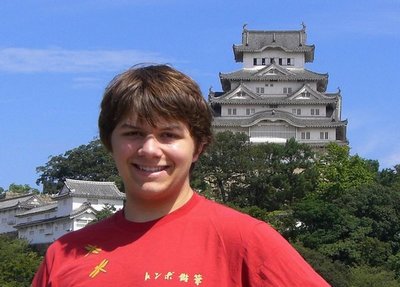July 5, 2007
Materials world: Materials scientists going places as part of the UW’s global scope
Travel the world. Meet fascinating people. Study materials science.
Surprised by the punch line? The UW’s Department of Materials Science and Engineering offers many ways for students to conduct research on other continents. Undergraduates and graduate students are traveling to Japan, China and Germany to forge scientific and cultural partnerships.
“We want to train the next generation of scholars so they know how to work in an international setting,” said Raj Bordia, a professor of materials science and engineering.
The UW is promoting a global perspective in many areas. And a peek at just one department — material science and engineering — shows how this global push looks on the ground.
The largest study-abroad program for materials science undergraduates at the UW is the University of Washington-Sichuan University (UW-SU) exchange program. Established in 2000 by Gretchen Kalonji, then a professor of materials science, the program sends UW students abroad for a year and welcomes Chinese students to Seattle. The program attracts undergraduates from all majors — anthropology, biology, architecture — but also draws consistently from materials science.
“The program is really about exposing students to China and exposing them to research,” said program manager Nancy Meenen. Fifteen students, including four engineers, will fly this August to Sichuan. The following year the 15 Chinese counterparts will spend an academic year at the UW.
One of the American students who participated in the UW-SU program is Ravi Mikkelsen, who graduated in 2005 with a bachelor’s degree in materials science and engineering. He recalls a freshman orientation session that outlined the exchange program’s opportunities to research topics such as water quality and hydrogen fuel cells.
“I was like hydrogen fuel cells — wow!” Mikkelsen recalled. “Right when [the presenter] said that, I knew that was what I wanted to do.” He spent his junior year at SU, studying and working with other students on water quality, environmentally-friendly industrial practices and biodiversity. He now works in Seattle promoting renewable fuels such as biodiesel.
Recruiting undergraduates for these programs can be difficult, Bordia said. Participation means additional costs and, especially for engineering majors, longer to complete a degree. But the tide may turn as students sense global corporations want to hire people with international experience.
“Students are seeing these experiences as benefiting their future job prospects,” Bordia said.
Competition for the program in China is fierce, Meenen said — about 50 students apply for each spot. Many of the Chinese students who come to Seattle are materials science or civil engineering majors, and some end up choosing the UW for graduate school. “It’s an excellent recruiting tool,” said Bordia, who has an SU graduate in his lab.
The UW-SU program isn’t the major travel agent for students working with Fumio Ohuchi, a professor of materials science and engineering. Ohuchi’s group established a formal research partnership in 2003 with the Japanese National Institute for Materials Science that stipulates joint training of students. So far, 10 of Ohuchi’s students have travelled to the NIMS campus. The lab is located in Tsukuba, a modern Japanese “science city” founded in 1987 and now home to about 100 laboratories. Three of Ohuchi’s students have spent a full year in Tsukuba, and others have spent a few months.
This summer, for the first time, a freshman student traveled to NIMS. Kevin Bell, a physics major who is enrolled in the College of Engineering’s technical Japanese program, will spend three months working in a lab testing new materials for computer chips.
“I thought NIMS would be a great opportunity to learn materials science and applied Japanese at the same time,” Bell wrote in an e-mail. While he’s getting experience in a “real” research in lab, he said working eight or nine hours a day is a pleasant change from school, and leaves him time to socialize and experience the local culture.
It’s not only American students who benefit from international exchanges. Ohuchi emigrated from Japan in 1976, when the numbers of Japanese academics coming to America to study was still high. But today, he said, fewer Japanese scientists see a need to travel.
“One benefit of having our students over there is it really stimulates the Japanese students’ interest in going abroad,” Ohuchi said. “In order to promote science, I think one of the most important things is curiosity.”
Typically graduate students travel more than undergraduates. Bordia estimated that about half of his doctoral students spend time in a lab overseas. Some went through one of the UW’s Integrative Graduate Education and Research Traineeship programs, while others simply visited collaborators in other countries.
“They really get exposed to the scientific culture in different parts of the world,” Bordia said.
The UW encourages international partnerships and there are opportunities for students in every department to go abroad. Even Ohuchi doesn’t see having a lab split between Seattle and Japan as unusual. “I think we’re just an extreme case,” he said.



